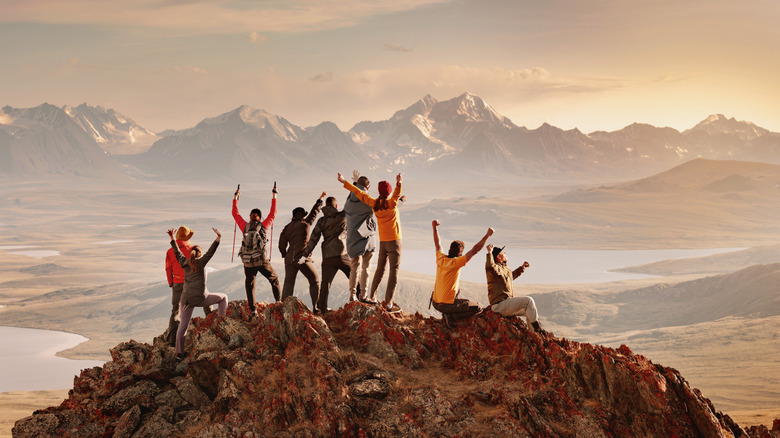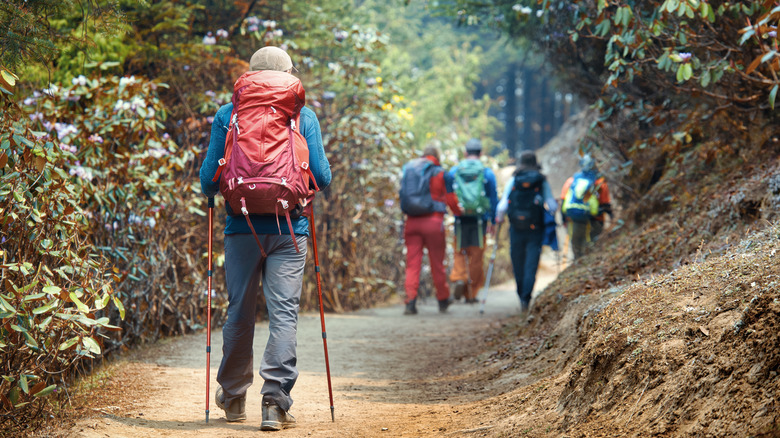The Dangerous Group Hiking Mistake That Could Potentially End In Disaster
If you've ever watched a thriller or horror film, you're likely familiar with that inevitable moment when the group decides to split up. Suspense begins to build immediately, and you can just feel that something bad is about to happen. You may even find yourself wanting to yell, "Stay together!" at the characters. That's your survival instinct kicking in. The common "splitting up" trope is used to move the plot along, but it's also a reminder that there's safety in numbers.
Next time you're embarking on an outdoor adventure, you'd be wise to remember what happens in scary movies when the group decides to separate. It's almost never good. Obviously, the films are fake and full of cliches, but when out in the wilderness, the danger of getting separated from the group is very real.
Hiking with a group can make the whole experience more fun, and it's also a great way to ensure you have a safe day on the trail. Most experienced outdoor recreation enthusiasts agree that hiking with a group of people who have a little experience in the outdoors is the safest choice. That being said, if you're out on the trail with a group, you'll want to ensure you stick together. Separating yourself from the pack is a big mistake that could have dangerous consequences.
Safety in numbers
Plenty of experienced hikers feel comfortable hitting the trail solo, but if you're just starting out you'll be better off going with others — and sticking by their sides. There are all kinds of high-risk situations you could encounter on the trail. You might need to cross a river, scramble up a steep incline, or change course if the path becomes too hazardous. Weather can be unpredictable, and if a surprise thunderstorm pops up, you may need to seek shelter and hunker down for a while. You could run into a bear, sustain an injury that renders you immobile, or get lost while hiking. When at the mercy of Mother Nature, things can quickly go from magic to tragic. Even experienced hikers can run into problems on difficult hikes with unfamiliar terrain.
Regardless of which dangerous scenario you find yourself stuck in, you'll be better off with other people around. You can combine efforts and share survival skills to come out of the situation unharmed.
Hiking with a group isn't without its challenges. You'll lose a bit of your independence in exchange for safety and company. There may be people who are less experienced, or who require more breaks than you're used to. Alternatively, you may feel as though you're the one slowing down the group, which could cause you a bit of self-consciousness. There may be someone feeling extra chatty when you'd prefer to listen to the sounds of nature. Even so, don't make the mistake of ditching the group. "While it may take a bit longer to reach your ultimate destination, staying together helps reduce the chance of someone getting lost, and if someone gets injured you are there to help," the National Park Service advises.
How to ensure that the group sticks together on a hike
According to the National Park Service, sticking together is one of the smartest things you can do when hiking. If you're with a large group, it can sometimes be a bit challenging to stay together. Before setting off on your hike, you should discuss your plan with the group. Make sure everyone knows the duration of the hike, the route, and the destination.
Discuss your intention to remain together. Create a plan in case someone gets separated. Perhaps you could come up with an easy to reach meeting point. If the group is large, you may want to use the buddy system. When each hiker is assigned a buddy, you will be able to quickly notice if one person gets separated. If hiking with a large group of kids, have each child count off before starting the hike. Repeat the count off with each child calling out their assigned number throughout the day so you know everyone is present. If you need to pause to rest, drink water, or relieve yourself — make sure you let the group know. Scheduling regular check-ins every hour or so to regroup and ensure everyone is comfortable is a good idea.
You'll also want to designate a "leader" and a "sweeper." The leader's job is to set the pace. Choose one of the slowest hikers for this role in order to set a manageable speed for the group.The sweeper's job is to ensure no one falls behind. If you do become separated while hiking, the first step is to call out. Carrying a whistle can be useful in notifying your group of your location.


